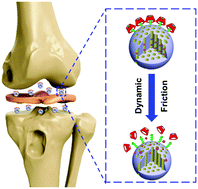Mechanised lubricating silica nanoparticles for on-command cargo release on simulated surfaces of joint cavities†
Abstract
We describe a type of supramolecular host–guest function silica nanoparticle activated by energy conversion from joint movement. The high coefficient of friction from damaged joints causes more energy conversion, weakening the surface host–guest interaction and resulting in target cargo release. Additionally, the hydrated layer on the nanoparticle surface plays a role in lubrication enhancement.



 Please wait while we load your content...
Please wait while we load your content...